I have seen a lot of guys standing around at Home Depot trying to figure out the differences between the Traeger Pro Series and Ironwood grills. Spotting the differences can be tricky because, on the surface, they look pretty similar.
At first glance these grills look similar as they are all powered by Trager’s new D2 Direct Drive and WiFire control systems, have similar body styles and operate from the same basic principles. These grills all come with a single meat probe and a magnetic door at the base of the pellet hopper for easy clean out.
Despite the similar appearances there are significant differences between the models. Based upon these differences, if I was in the market to buy a Traeger, then I suspect that I would buy an Ironwood instead of the Pro Series.
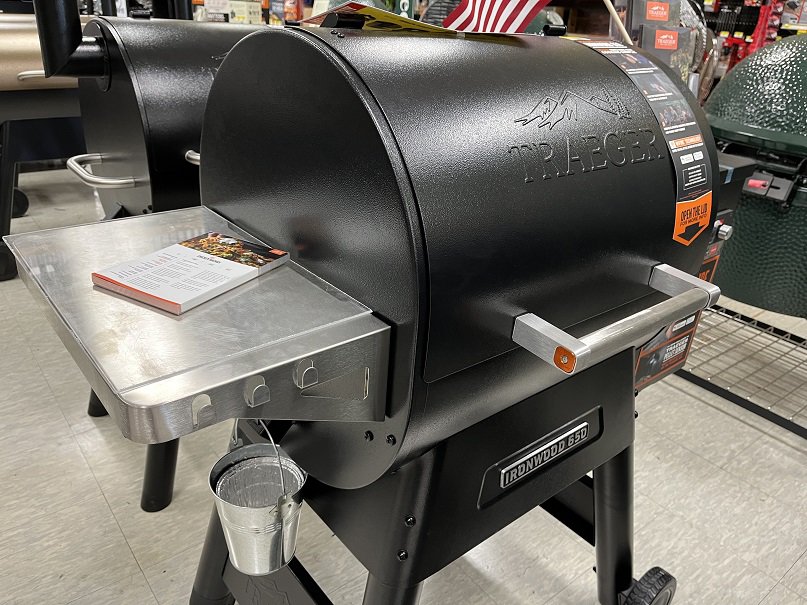
This article is going to focus on the main differences between the Traeger Pro and Ironwood Series so you can decide if the upgrade to the Ironwood is worth your money.
If you are interested in the Timberline grills then this article on the Traeger Ironwood vs Timberline will help you understand what you will get with the larger upgrade.
Overview of the Traeger Pro Series 575 and 780
The Pro Series is the base model grill and comes in two sizes, the 575 model and the 780 model. Other than size there are no meaningful differences between the 575 and 780. To dig deeper into these models check out this article of Traeger Pro 575 vs 780.
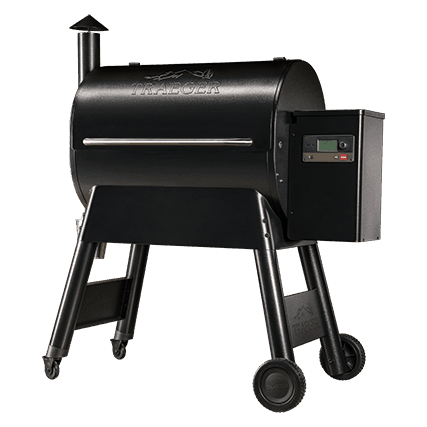
Traeger Pro Series 575 and 780 Specifications
- Primary Cooking Grate: 22 x 19 inches (575 model), 30 x 19 inches (780 model)
- Secondary Cooking Grate: 22 x 7 inches (575 model), 30 x 7 inches (780 model)
- Grill Capacity: Five Racks of Ribs (575 model), Six Racks of Ribs (780 model)
- Hopper Capacity: 18 pounds of pellets
- Maximum Temperature: 450F
- Vent: Smokestack Chimney
- Grease Management: External drain to bucket
- MSRP: $899 (575 model), $999 (780 model)
The Pro Series are nice grills and if I wanted to spend less than $1,000 bucks then these would be fine choices.
Please note: There are two versions of Tragers being sold as “Pro Series” and they are NOT the same. The older Pro Series are now being called “Generation 1 Pro Series” and have the outdated control panel and drive train.
If you see the following control panel on a Traeger then it is on one of the older Pro 22 or Pro 34 grills being sold at Home Depot.
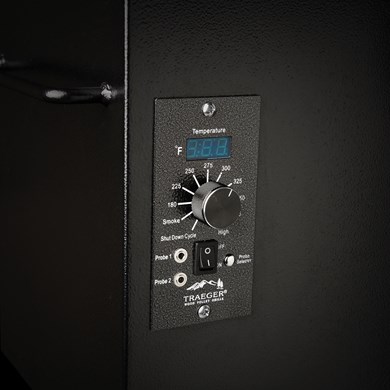
Pro Series User Reviews
I compiled the user reviews for the Pro series from the reviews left at Ace Hardware, Traeger, Home Depot and BBQ Guys. Here is what the data looks like.
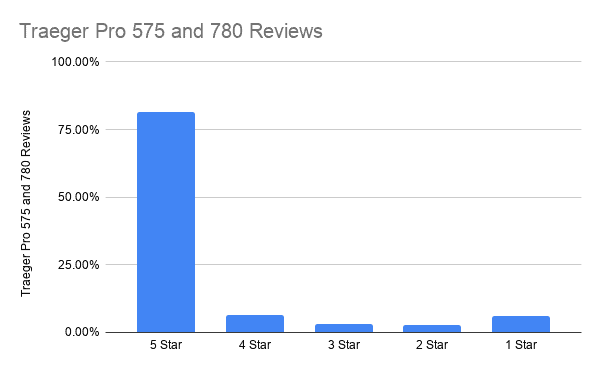
When you combine the 5 Star ratings (81%) with the 4 Star ratings (6%) you see that 87% of the folks that left reviews really like their Ironwood grills. Only 9% of users hated the grills enough to leave a 1 or 2 Star review.
I will go on my standard rant about the size of the pellet hopper for the Pro Series. The hopper on the Pro Series can hold 18 pounds of pellets. Wood pellets are sold in 20 pound bags. It drives me crazy when a grill can’t handle a full bag of pellets! It is stupid to have to wrap up the remaining two pounds of pellets and store the bag someplace dry in your garage.
Overview of the Traeger Ironwood Series 650 and 885
The Ironwood grills are upgrades from the Pro series and come in two sizes, the 650 model and the 885 model. Other than size there are no meaningful differences between the 650 and 885.
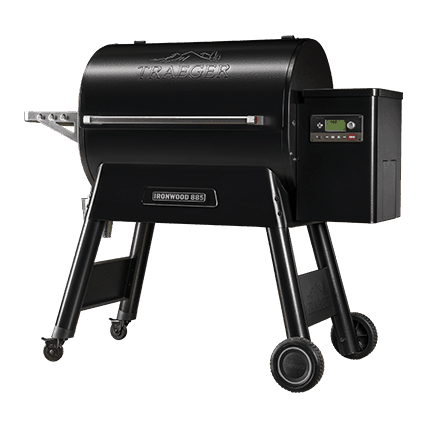
Traeger Ironwood Series 650 and 885 Specifications
- Primary Cooking Grate: 22 x 19 inches (650 model), 30 x 19 inches (885 model)
- Secondary Cooking Grate: 22 x 10.5 inches (650 model), 30 x 10.5 inches (885 model)
- Grill Capacity: Five Racks of Ribs (650 model), Seven Racks of Ribs (885 model)
- Hopper Capacity: 20 pounds of pellets
- Maximum Temperature: 500F
- Vent: Rear Exhaust
- Grease Management: External drain to bucket
- MSRP: $1,399 (650 model), $1,599 (885 model)
The Ironwood Series are the grills that Weber used as a benchmark when they launched their Smokefire pellet grills. Check out how they did in this article: Weber Smokefire vs Traeger: The Reviews Are Shockingly Awful!
Ironwood User Reviews
I compiled the user reviews for the Ironwood series from the reviews left at Ace Hardware, Traeger, Home Depot and BBQ Guys. Here is what the data looks like.
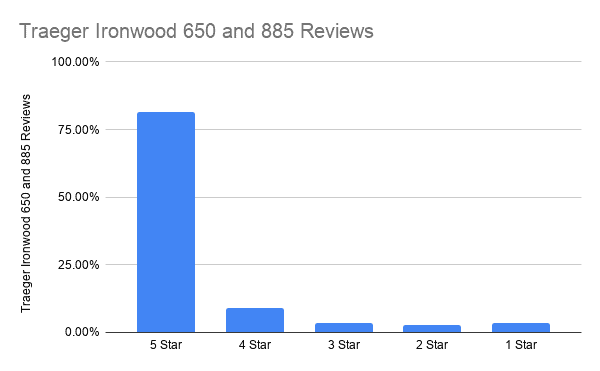
When you combine the 5 Star ratings (81%) with the 4 Star ratings (9%) you see that 90% of the folks that left reviews really like their Ironwood grills. Only 6% of users hated the grills enough to leave a 1 or 2 Star review.
Traeger Pro Series vs Ironwood
The most obvious difference between these grills, cooking area, is the least important. For example, the Pro Series 575 has roughly 575 square inches of cooking area between the top and upper grate compared with 650 square inches on the Ironwood 650. However, the 13% more grilling space on the Ironwood is the result of the top grate being 10.5 inches wide instead of 7 inches on the Pro. This size difference is irrelevant and is reflected in the fact that both grills can only handle five racks of ribs.
So if size isn’t the big difference then what is?
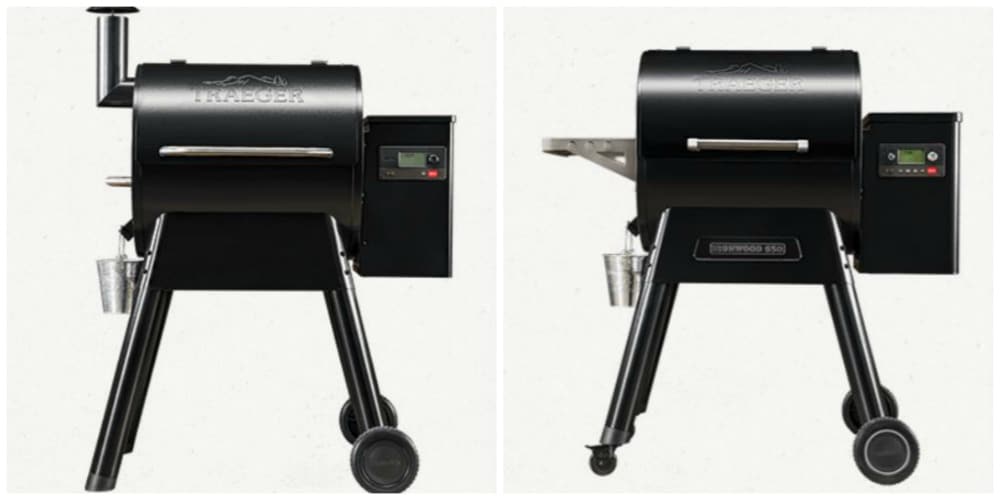
Upgrades for the Ironwood include:
- Better Heat Retention
- Upgraded Pellet Hopper
- Better Exterior Hardware
- More Smoke Flavor
Let’s look at each of these upgrades in a little more detail.
Ironwood Grills Have Better Heat Retention than Pro Series Grills
The Ironwood grills come with double wall construction and a gasket lid liner for better heat retention than you will get on a Pro Series grill.
If you will be smoking in cold or windy conditions then you should expect the Ironwood grills to:
- Use fewer pellets
- Have fewer temperature swings
The reduced pellet usage isn’t that big of a deal but fewer temperature swings is a significant upgrade.
The Pellet Hopper is Better on the Ironwood Grills
The Pro Series grills have an 18 pound pellet hopper which I always thought was silly as Traeger sells their pellets in 20 pound bags. The Ironwood grills have a 20 pound hopper so you can pour in a whole bag of pellets.
The other upgrade on the hopper is a sensor in the top of the hopper that alerts you through the WiFire app when the pellets get low above the auger. This feature gets mixed reviews as some folks love it and other find the alerts to be annoying. Your mileage may vary.
Ironwood Grills Have Better Hardware
The biggest hardware upgrade on the Ironwood is that it comes with a stainless steel working side table equipped with tool hooks. There is no side table on Pro Series grills.
The addition of a side table make a world of difference that you will appreciate the first time you head out to your grill and need a place to put a tray of ribs and your bottle of spritz.
A secondary hardware upgrade on the Ironwood is the addition of casters on the left side of the grill so you can easily roll the grill around on your deck. There are no wheels on the left side of the Pro Series so you need to pick up the left side by the handle and maneuver the grill with a little more force if you want to move it.
Ironwood Grills Have More Smoke Flavor than Pro Series Grills
The biggest difference between the Pro and Ironwood grills is that the Ironwoods produce more smoke flavor than the Pro grills. This difference is accomplished by the combination of:
- Rear Mounted Smoke Vents
- Super Smoke Mode
For years one of the biggest complaints about pellet smokers was that they did not produce enough smoke flavor. I know of one competition barbecue team that resorted to using Liquid Smoke in their brisket injection when they were cooking on a pellet grill to boost the smoke flavor profile (and they have scored a perfect 180 using that trick!).
One reason that pellet grills didn’t provide full smoke flavor was because the wood pellets burned so cleanly that they didn’t produce much smoke. The other reason was that what little smoke they did produce quickly rose with the heat and vented out the top mounted smoke stack.
Traeger has taken a two-fold approach to this problem by eliminating the smoke stack and building the Super Smoke feature into the controller!
The Ironwood does not have a smoke stack!
Instead, there are a series of vents in the back of the grill located close to the grate. With this design the smoke that is produced still rises with the heat but must be pulled down and across the meat before it can vent to the atmosphere. With the rear based vent configuration on the Ironwood you get:
- Better convection cooking (10% faster cooking times)
- Better smoke flavor
- Better smoke rings
The Ironwood also comes with a Super Smoke feature that enhances smoke flavor. The Super Smoke mode is available when the Ironwood is at temperatures between 165 and 225F. Unlike other pellet grills that blow billowing white smoke when in “Smoke” mode, the Traeger produces more of the thin blue smoke that you want.

Comparative User Reviews of the Pro and Ironwood Grills
When you compare the user reviews for the Pro Series against the user reviews for the Ironwood it is hard to tell the difference.

The amount of 5 Star reviews for both product lines come in at 81%. When you combine the 5 and 4 Star reviews the Ironwood barely beats the Pro with a 90% satisfaction rating compared to 87% for the Pro.
| Traeger Pro vs Ironwood Reviews | Pro | Ironwood |
| 5 Star | 81.37% | 81.42% |
| 4 Star | 6.47% | 9.06% |
| 3 Star | 3.06% | 3.56% |
| 2 Star | 2.93% | 2.64% |
| 1 Star | 6.16% | 3.33% |
Is the Traeger Pro or Ironwood the Right Grill For You?
Picking between these two series of Traeger grills is a tough proposition.
The Ironwoods are clearly the better grills as they offer better temperature control in rough weather and more smoke flavor at all times.
That being said, you will be paying one heck of a premium for the upgrades on an Ironwood and you will have to decide if it is worth it.


